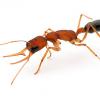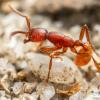I think it’s unfair to compare Solenopsis invicta and Tetramorium immigrans. Both are invasive, but there’s really no comparison in terms of environmental destruction.
Keeping a non-native ant *in your house* is really no different than keeping a non-native house plant. It may actually be preferable to catch and remove non-native queens from the local breeding pool. The caveat is that you should not release or move around any invasive species by any means.
For example, I despise English Ivy because it chokes and kills the native trees in my region leaving behind a barren monoculture. I adore the pretty white and green ivy that I have growing in my office, though.
I think it would be fair to compare the two. Solenopsis invicta is a far worse invader than Tetramorium immigrans, and there are some invasive ants out there that have little to no impact on the environment. Take Strumigenys membranifera for example, or Gnamptogenys triangularis, or even Platythyrea punctata. None of those species are common enough to pose a real threat to the environment, and Strumigenys membranifera are to small to worry about at all. They eat springtails, and can easily be forced out by native ant species, and actually live symbiotically with some species. So yeah, it is fair to say that some exotics are worse than others.
Unless there is some research that has demonstrated any of the aforementioned exotics have ZERO to LIMITED impacts on endemic ecosystems the prudent default would be they ARE having an effect. Neil J. Reiner in his research of exotic ants of Hawaii (all ants in Hawaii are exotics) has demonstrated multiple effects on various arthropod classes. He wrote, "Experimental and observational evidence has shown that the Hawaiin ant fauna, composed entirely of alien species, has had a devastating effect on the native terrestrial fauna"(pg. 19). Similarly Harold G. Fowler, Marcelo N. Schlindwein and Maria Alice de Medeiros in looking at exotic ants and their effect on native ant assemblages noted, "...it is apparent from documented cases in island systems that exotic ants generally displace other endemic ants..." (pg. 157) Though continental ant fauna have revealed few significant population reductions it was noted "this is NOT an unbiased sample"(pg. 157) (my emphasis). Meaning, more research must be done and implying effects may be occurring but not being researched and demonstrated. The upshot is more research needs to be done on even the aforementioned less publicized and studied exotics. We should consider any exotic as a potential displacer and threat to endemic species of not only ants but arthropods and all the connected relations they have with plants and the wider biomes and biotic communities they encounter. CITATION: Exotic Ants: Biology, Impact and Control of Introduced Species (1994) David. F Williams, Westview Press, Boulder CO
The following "high local abundance of N(ylanderia) flavipes may give it a competitive advantage and affect native ants through exploitative competition." is from https://engagedschol...text=etdarchive. You are free to read it and also review its literature list.
And the following short pdf: http://issg.org/data...eantimpacts.pdf
Edited by PurdueEntomology, April 27 2020 - 5:58 AM.




















